Arbormageddon ice storm smites Austin’s trees
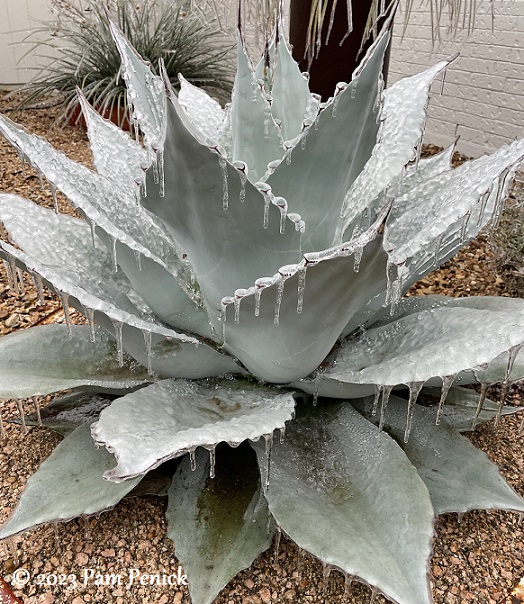
Most people’s gardens get shadier over time. Mine is growing sunnier. Extreme weather events over the past 15 years — droughts, hotter summers, and Snowpocalypse — have stressed and thinned the tree canopy in my garden. A week ago, on February 1st, Austin took another pummeling when an ice storm struck. Arbormageddon, local wags soon dubbed it.
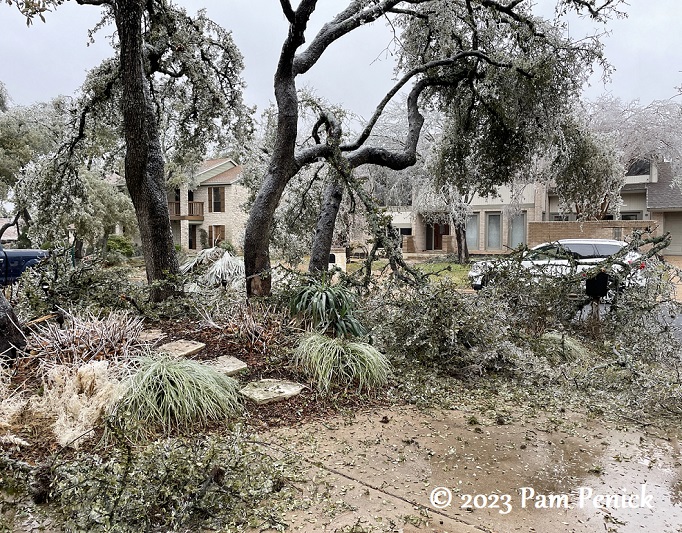
It wasn’t all that cold — a degree or two below freezing — but even so, more than a half-inch of ice encrusted Austin’s trees. Live oaks hold their leaves all winter. Weighed down with ice, and stressed from extreme weather over the last few years, many of them couldn’t bear the strain. For two days and a night we winced to hear trees cracking, limbs snapping, and crashing thuds all around our house.
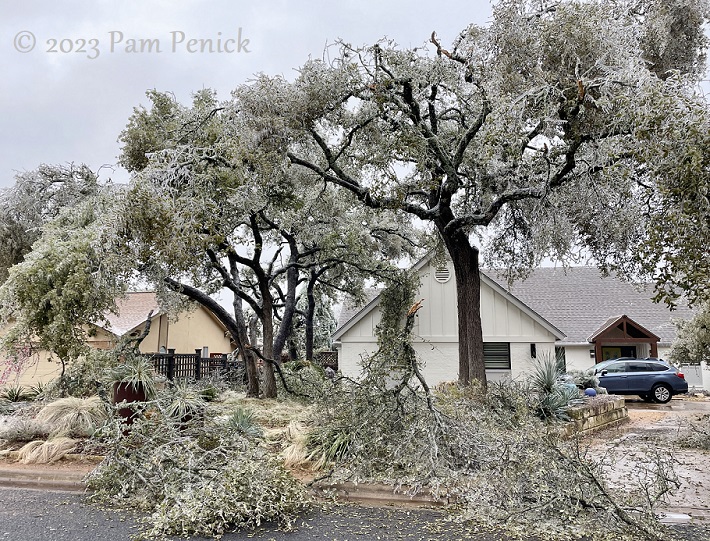
Trees across the city also fell onto power lines, sending homes and businesses into days of darkness and cold. On our block, 6 days crept by before power was restored. After seeing the damage across town, I’m certain that Austin Energy’s crews and those borrowed from other cities were working as fast and as hard as they could, in dangerous conditions, to get power lines back up.
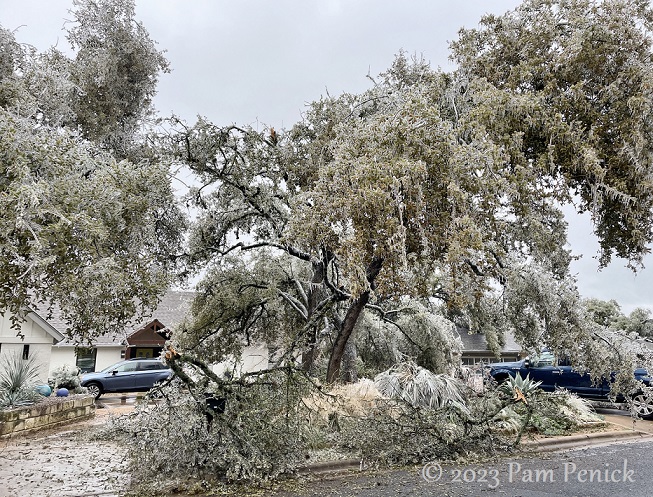
We are lucky that our house and vehicles, deck and patio were largely untouched. A few fencing panels sustained damage, and we lost an A/C unit.
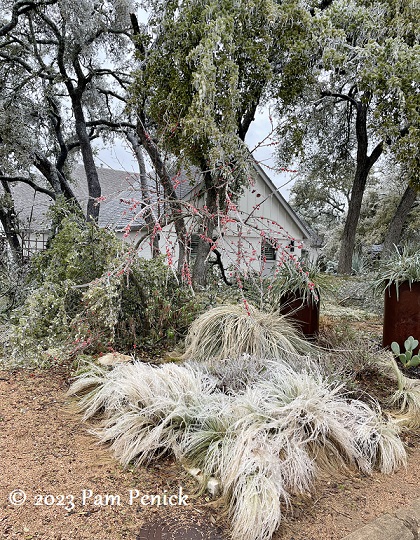
About 50% of my understory trees, like this red-berried possumhaw, were crushed by falling limbs. But the agaves, big yuccas, bottle tree, and stucco walls survived. It was bad but could have been a whole lot worse.
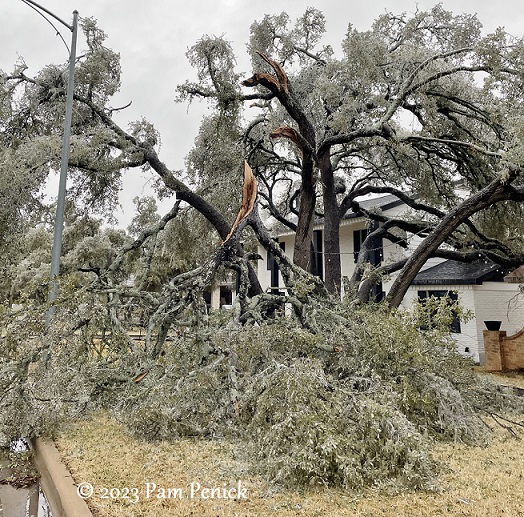
Along our street, broken live oaks looked as if a small tornado had whirled through.
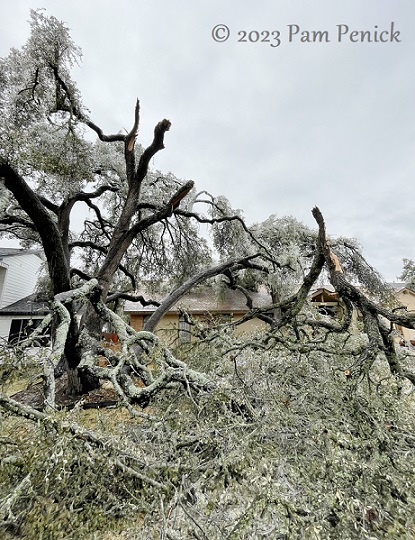
Trees in my neighbor’s yard
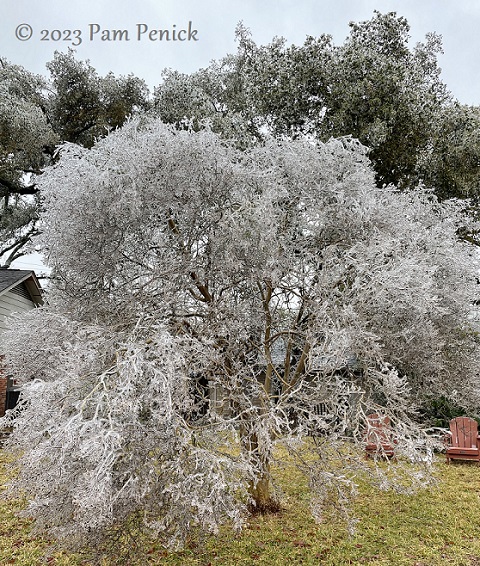
Crape myrtles held up well overall. This one at a neighbor’s house was lovely all frosted with ice.
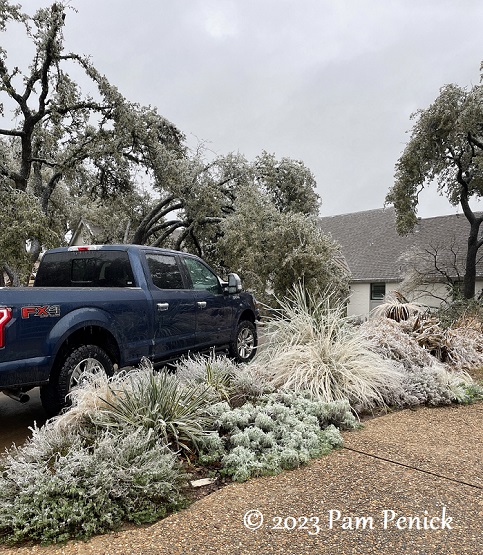
While sad about our trees, I found moments to appreciate, like my driveway border, looking pretty even in late winter and under a layer of ice. No trees here to crush anything! Hooray for ornamental grasses, yuccas, purple skullcap, and ‘Powis Castle’ artemisia.
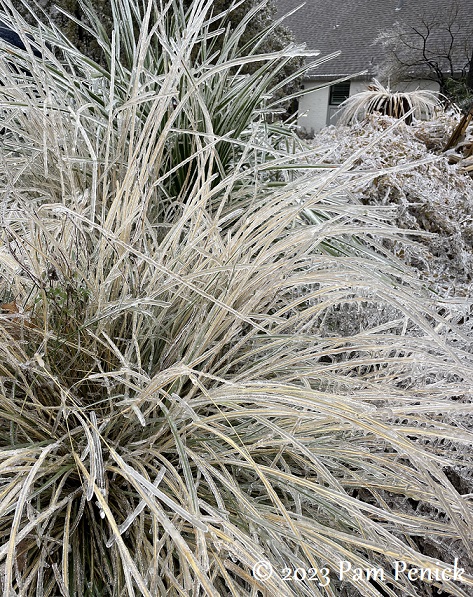
Pine muhly (Muhlenbergia dubia), one of my tough-as-nails favorites, coated in ice
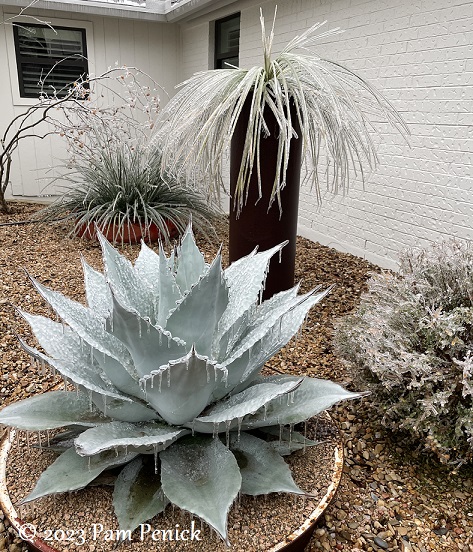
Whale’s tongue agaves (Agave ovatifolia) sailed through the ice storm, as did red yuccas (Hesperaloe parviflora). The Anacacho orchid tree in back bent to the ground under the ice but has already straightened up. The toothless sotol in the steel pipe may be a goner though; it didn’t like December’s Arctic freeze either.
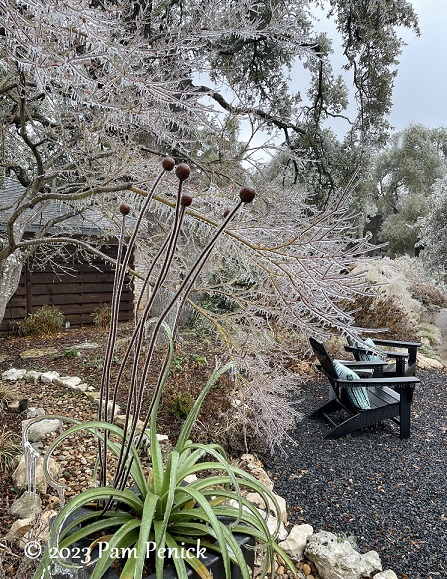
Squid agave (Agave bracteosa) can easily handle low 30s temps and ice, even in a pot. The Japanese maple bent but did not break — and thankfully falling live oak limbs missed it.
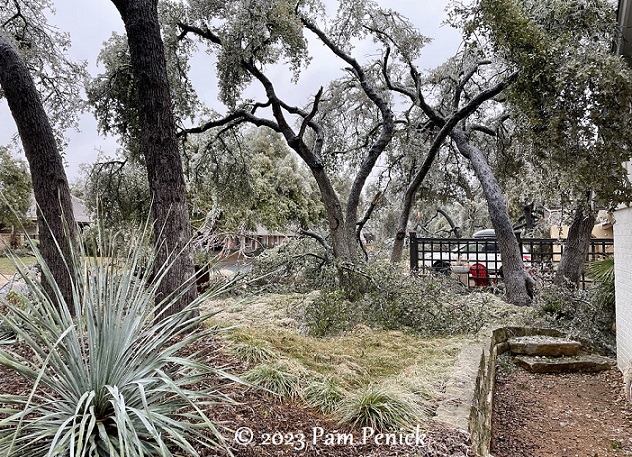
My husband spent the weekend sawing and hauling limbs and stacking them along the street. I did the same with smaller limbs on Monday. On Tuesday our tree guy arrived and spent the entire day removing dangerous broken limbs from the canopy as well as gigantic limbs on the ground that were too big for us to easily tackle.
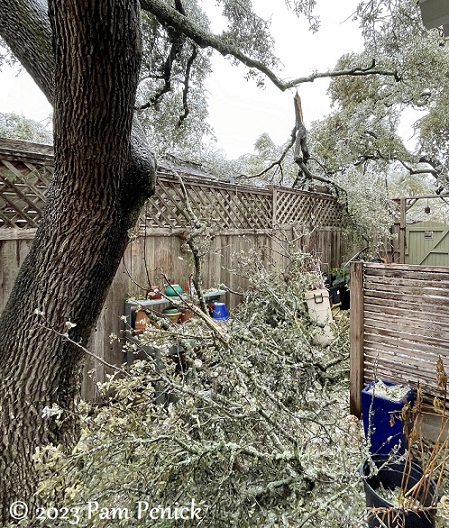
How things looked throughout our yard before all the cleanup
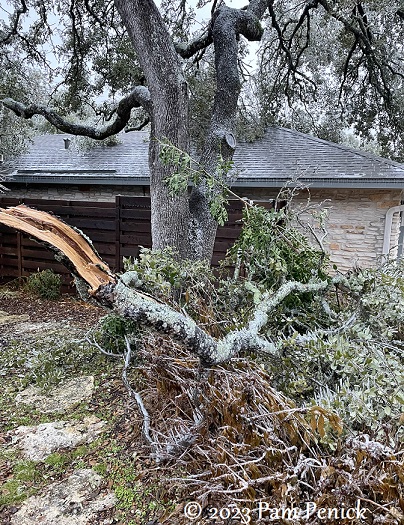
The Texas mountain laurel my daughter grew from seed — which had mostly recovered from Snowpocalypse damage — took a direct hit from a big live oak branch.
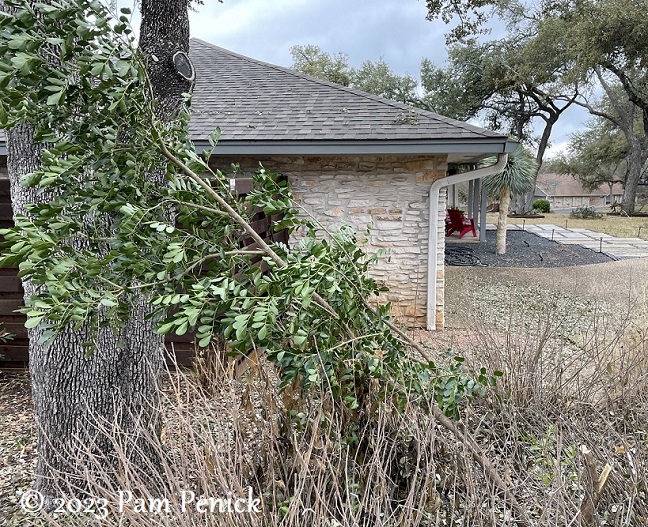
Half of it was snapped off, and the other side is now leaning at a 45-degree angle. I think it’ll live though. We’ll stake it to try to get it upright again.
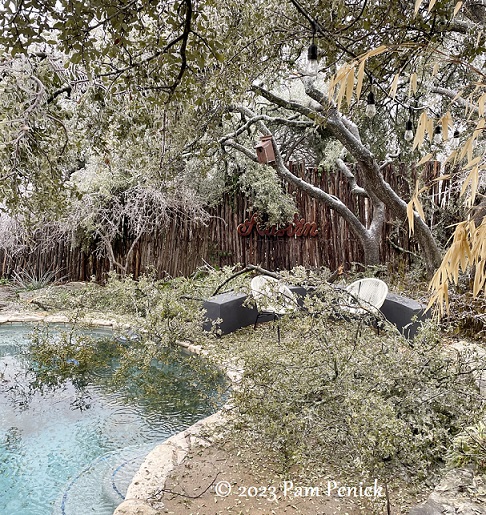
The owl box tree lost about half its canopy. One big branch landed in the pool. Another on the stucco wall. The chairs and wall were spared – yay!
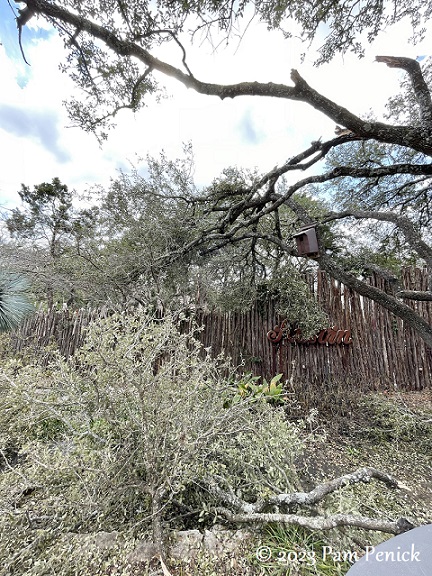
Another angle shows the extent of damage to the tree.
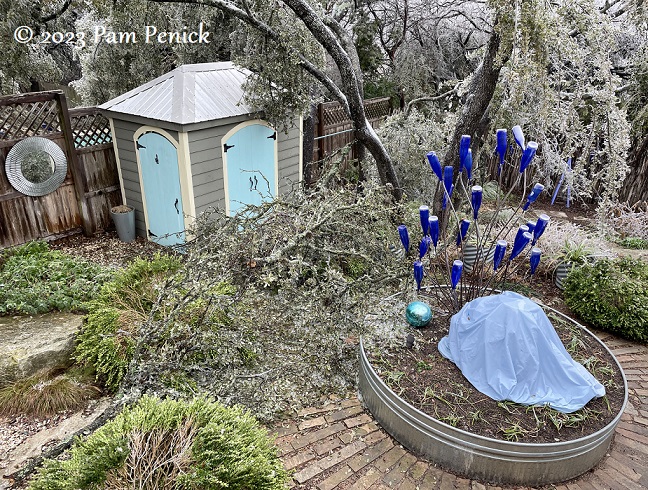
A big limb came down on the other side of the garden but missed the shed and bottle tree. Two of the boxwood balls sustained some broken branches, but at least they’re still standing.
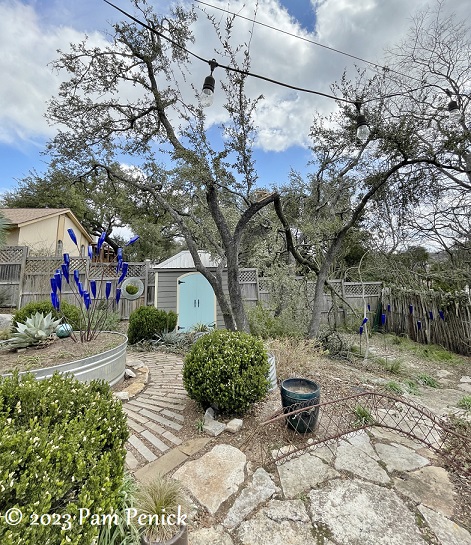
This cluster of live oaks, which were recovering from having their root zone buried long ago, lost significant branches. I hope they’ll be OK. A metal arbor (lying in the foreground) took a direct hit that broke it.
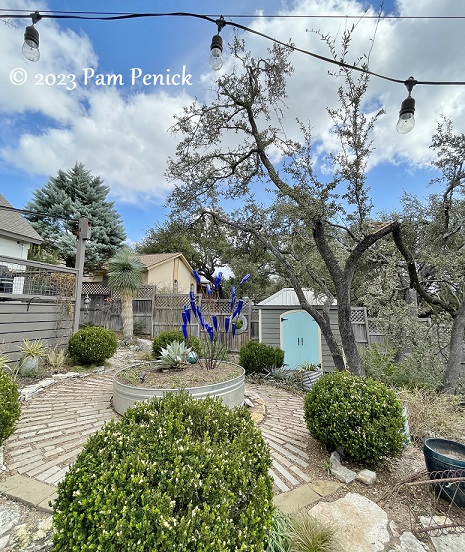
This space is going to be much sunnier and hotter this summer. But that means different plants to try. I’d been leaning toward planting sedge in my stock-tank planter. But now, with less shade, I’m considering silver ponyfoot after all.
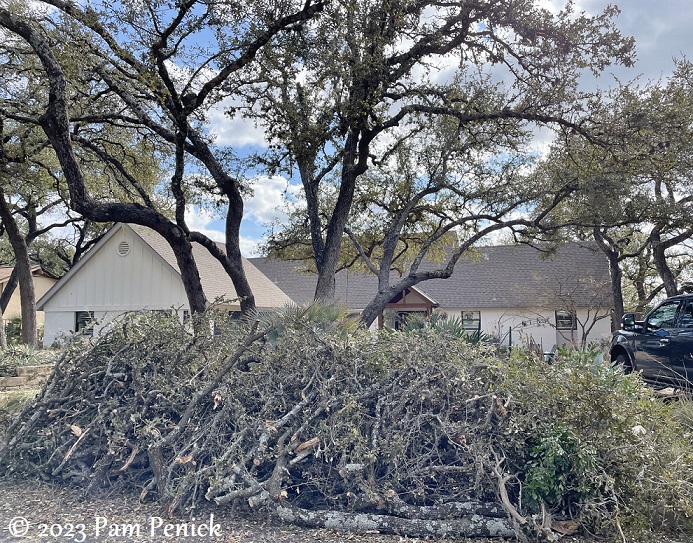
Meanwhile, until the city picks up our Arbormageddon pile or our tree guy can get to it, we’re enjoying our newly fortressed home. This 6-foot-tall pile of stacked limbs (does not include the full day of cuttings our tree guy hauled off) stretches all the way along our street frontage, from here along the island bed…
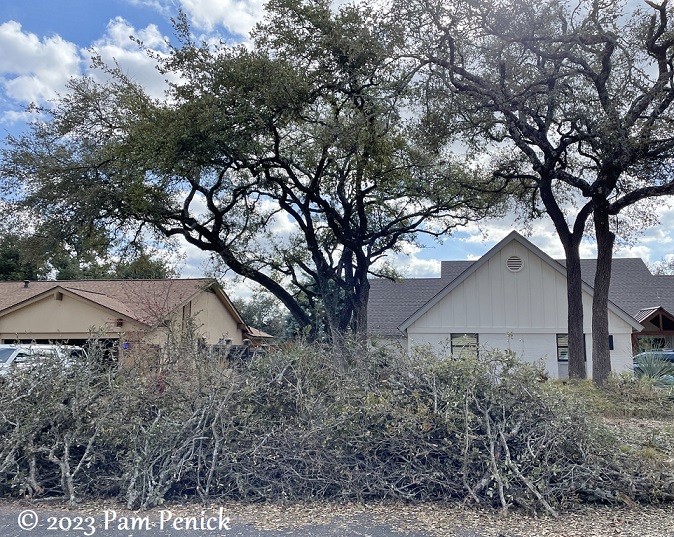
…to the property line on the other side of the driveway.
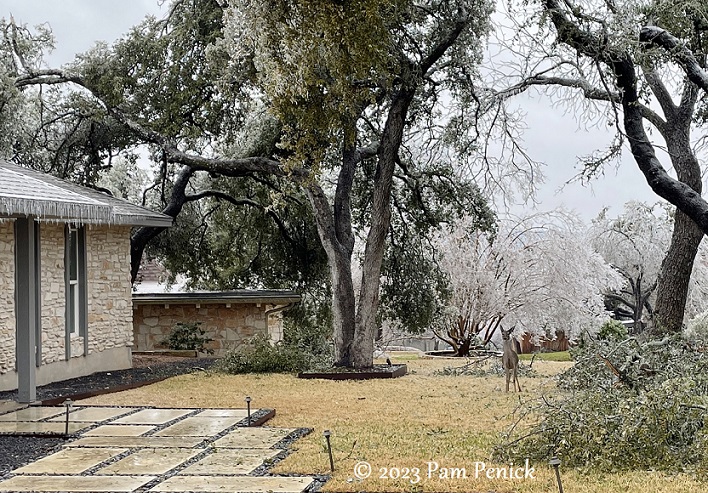
If only it could keep out the deer, it might be a worthy trade – hah!
Pruning damaged oaks? Do this to avoid spreading oak wilt, which kills trees
If you have ice-damaged oak trees, especially live oaks or red oaks, here’s what you need to know. The tree disease oak wilt is lethal to most live oaks and red oaks that get it, and it spreads easily from a sick tree to a healthy one. The fungus that causes oak wilt spreads in two ways: 1) underground through interconnected tree roots and 2) above ground via a beetle that’s attracted to tree sap (from cuts and wounds) and is most active from February through June in Central Texas.
We are currently in the do-not-prune months for live oaks to prevent the spread of oak wilt. Obviously, you need to cut dangerous hanging branches out of your trees right now so they don’t fall on you or passersby. Get this done as soon as possible, and make sure those cuts are immediately sealed with paint — right when the cut is made to prevent the beetle from getting into it.
But don’t prune all the ugly tears and amputated limbs on your oaks right now. The trees will have sealed off those wounds within the first few days of injury. Cutting those now just opens your trees to oak wilt exposure. Schedule non-emergency, aesthetic pruning in July or later. Late fall is best, when trees are no longer summer-stressed. Here in Central Texas, oak pruning should be done July through January, when the oak wilt beetle is less active. Also, remember to sanitize pruning tools before starting and between trees to prevent the oak wilt fungus from spreading from tree to tree.
Click here for more info about oak wilt and how to prevent its spread.
__________________________
Digging Deeper
Come learn about gardening and design at Garden Spark! I organize in-person talks by inspiring designers, landscape architects, authors, and gardeners a few times a year in Austin. These are limited-attendance events that sell out quickly, so join the Garden Spark email list to be notified in advance; simply click this link and ask to be added. Season 8 kicks off in fall 2024. Stay tuned for more info!
Experience the Surreal Garden at Zilker Botanical Garden, an enchanting neon-art display throughout the gardens, with food and drink, music and dancing, surreal performers, and interactive art sculptures. Surreal costumes encouraged! 25% of event proceeds benefit the Zilker Botanical Garden Conservancy. Runs April 6 (VIP Night), April 7-8, and April 13-15, from 6:30 pm to 11 pm.
All material © 2025 by Pam Penick for Digging. Unauthorized reproduction prohibited.


Oh Pam, how devastating! Ice storms can ravage trees even when they DO lose their leaves in winter. Your oaks sure took a major hit – I’m so sorry! Your lead picture is beautiful however. I’m glad you’re able to see the beauty amidst the overwhelming amount of debris.
That storm delivered some single digit temps and howling winds in western Maryland; the next day snow crocuses were blooming in the lawn and the high was 50°. Crazy weather!!
Crazy weather indeed, and February is always the craziest month of all here in Texas. A few days after our ice storm, temps were in the mid-70s.
This is such unusual weather and I am so sorry to see your poor succulents being subjected to the winds and cold. We had a short spurt with temperatures in the single digits, which is even unusual for us, and we keep going from 50 degrees one day to in the 30’s the next, which is not good for the garden. We need to keep in mind that plants are more resilient than we sometimes give them credit for. Your garden still looks beautiful despite the debris.
Thanks, Lee. February is always an up-and-down month for us here in Texas, and ice is not even that unusual. But I’ve never seen anything like this ice storm in the 29 years I’ve lived here. I hope never to again!
I used to love seeing those mature oaks and the shade they provided to your garden. How very sad.
I appreciate you looking on the positive in the midst of the devastation, mentioning the things that evaded the falling branches. I’m looking forward to seeing you make lemonade of this unexpected lemon.
You can only move on from the wreckage and remind yourself that gardening is a process, not a destination.
Hello Pam – so sorry to see your garden being tested yet again this winter! I know in the UK having access to more sunlight into your garden would be a good thing- but can appreciate in Austin you really value the shade they provide.
I hope you do not get too many more days of cold winter. Here in the UK we have had a cold winter – alot of tender plants have been tested (likely to the limit here!).
Do Live Oaks grow quite quickly or will you be left with gaps in your canopy for years to come?
All the best
Owen
PS loving the whale tooth agave with icicles!
PPS I managed to find a baby Yucca rostrata in a garden centre before xmas in the reduced section and was made up – it will be years before it gets to look like much but cant wait to one day have a lovely plant like yours!
Live oaks are long-lived, slow growers, so I don’t think the gaps will be filled any time soon. But plants, and even trees, can surprise us, so who knows? Meanwhile I’ll see how my existing plants respond to more sun. Some of them will appreciate it. Others, not so much. Same with this gardener. It’s easier to garden in sun than in shade. But shade is such a valued feature in a hot climate.
In happier news, I’m delighted to hear you found a baby rostrata for your garden! I hope it grows well for you.
Based on your earlier Instagram post, I knew you’d been hit hard but I neverimagined damage to this extent. I’m guessing that, post Arbormageddon, you’ll be examining your garden as if it was an entirely new space. Will there be more crape myrtles in your future? Is your beautiful Japanese maple alright? I’m glad the succulents made it through the experience. That whale’s tongue agave looks like a sculpture.
Those whale’s tongue agaves are so photogenic, even under ice! 🙂 The Japanese maple survived with no damage, miraculously. Our existing crape myrtle lost one large limb but is otherwise OK. I don’t think I will plant more crapes though. Our crape struggles in summer, and our arborist told me he’s seeing that all over Austin. He ascribes it to our hotter, drier summers. If I do plant any more trees, they will be understory natives. Even with the decimated canopy, we still have a LOT of trees. No room to plant a new shade tree that will grow large, much as I’d like to diversify our tree species.
Oh. My. G-d!
That pretty much sums it up!
Gosh, your poor trees! It’s hard to imagine that many branches down from one event. It’s also hard to imagine power out for that long. Having the power out for a few hours is bad enough. But I’m glad most of your plants and trees will survive and will come out OK.
Me too, Beth. And am glad the house and cars and hardscape were largely spared.
Oh, the poor, poor live oaks in Austin and the Hill Country. Horrible to see so many limbs down. And you wonder if the damage will cause a gradual decline in the tree (not to mention wondering if that beetle made its way in). I know about limb piles. Hurricane Ike ripped through here (SE Houston) and tore up so many trees and shrubs. It took out the crown of our live oak. Everyone everywhere had tall brush piles. When driving through the streets, it felt claustrophobic. Continuous tall brush piles all along entire streets, no breaks. And it took the city months to clear them. I got so tired of seeing nothing but brush piles! You couldn’t see houses because of the tall piles. A couple of years later, we had to take down one of our American Elms and a Sweet Gum that had gone into decline from the damage. The Sweet Gum was large and provided a lot of shade, but I hated the gum balls, so I was not terribly upset with losing it, but the American Elm… I cried over losing it.
I fervently wish for the live oaks to recover, to prosper and regain their magnificence! I wish you the best with the new direction so much of your garden will have to take. I am sure you will meet the challenge!
I can’t even imagine going through the cleanup after a hurricane, with not only tree damage but structural and flooding damage. It can always be worse – ha! Thanks for the good wishes. Fingers crossed for the oaks!
During the Fling visit I marveled at the live oaks lining your neighborhood and how much character they imparted — what a tragic loss. Seems like making a garden now is a constant state of triage as extremes come from every angle — cold, drought, wet, heat, wind. Still, you’ve worked so hard on the “bones” of your garden that it seems to come through whatever the du jour weather apocalypse throws at it. Hope you’ve got a generator now! And omg so much cleanup — take care of yourself!
Thanks, Denise. And so true about the constant state of triage. A generator shall indeed be ours, as soon as we can get one. I hate that that’s necessary though. Anyway, we can now walk through the yard again without worry about trees dropping on us, so that’s a start.
[…] I fled to Houston during Austin’s ice storm aftermath earlier this February, I made a visit with family to Houston Botanic Garden. Even in Zone 9 […]
So sorry for your loss 🙁
Thank you, Jamie!
Oh! I never thought I’d see your garden hammered by winter again. Just as it was coming together after the last winter damage.
But – you will surprise us again with the new look.
Might the steel pipe be better for an art display pedestal. I imagine that steel would get very cold for roots?
Here in Austin we were quite surprised to be hammered by winter again so soon too. It was pretty different though from the deep freeze of 2021 — not very cold, but lots of destructive ice this time.
The steel pipe planters do as well as my ceramic pots in winter conditions. What matters more than the material, I find, is choosing plants that can handle a dip into the teens or lower. It used to be that Austin gardeners could push our 8b hardiness zone (which probably doesn’t mean anything to you in South Africa, but perhaps you have something comparable) with 9a plants, with few losses, at least for a while. But the past few winters, we’re all seeing that sticking with Texas natives is safer than pushing it with Mexico or Australia natives. Time to rein it back in, except for those who don’t mind rolling the dice!
[…] has always bloomed, even in the shade of all our trees. But one upside of last month’s ice storm that broke so many large limbs is more sun, and the crossvine has responded to it with a […]